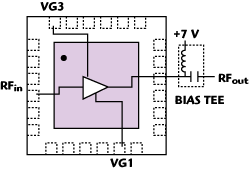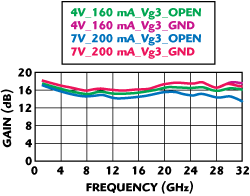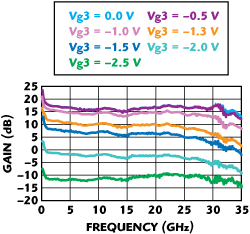 Mimix Broadband’s XD1008-QH is a packaged broadband PHEMT distributed amplifier designed for medium power output over the 500 MHz to 32 GHz frequency range. It features gain slope adjustment, wide dynamic range gain control, 50 Ω match on the input and output ports, and robust protection against ESD damage. The product is packaged in an industry standard 4 x 4 mm QFN, allowing the use of standard SMD production lines for installation.
Mimix Broadband’s XD1008-QH is a packaged broadband PHEMT distributed amplifier designed for medium power output over the 500 MHz to 32 GHz frequency range. It features gain slope adjustment, wide dynamic range gain control, 50 Ω match on the input and output ports, and robust protection against ESD damage. The product is packaged in an industry standard 4 x 4 mm QFN, allowing the use of standard SMD production lines for installation.
Distributed amplifier products historically address two principal markets: microwave instrumentation and defense, although communication systems have recently taken an interest in broader band performance of driver and power amplifiers. This is mainly due to the need to cover multiple octaves with broadband linear performance. The XD1008-QH has the benefit of being able to source a single device usable over the entire operating bandwidth of a communication system that must accommodate multiple services. Military systems, including C4I, surveillance, EW and ECM commonly cover frequencies from HF to millimeter wavelengths. Microwave test equipment is typically designed to make measurements contiguously from near-DC through millimeter wavelengths. The XD1008-QH provides this broadband performance in a single QFN plastic package with high output power and linearity.

Figure 1 XD1008-QH connection diagram.
The internal design of the XD1008-QH consists of nine stages of cascade connected PHEMT devices that ensure flat gain and return losses. The RF I/O ports are DC coupled. The external bias-T is a key component of the application of this packaged device (see Figure 1). External input and output coupling caps must present a low, resonant-free impedance across the desired RF bandwidth. At the lowest frequency, XC should be small compared to 50 Ω. At the high end of the application band, these large external capacitors and their inherent parasitics may produce series and parallel resonances. Specialized broadband caps are necessary and are available from multiple vendors. The design of the choking inductor depends greatly on the use of SMT vs. printed components, and careful selection and design is needed to maximize performance.

Figure 2 XD1008-QH gain vs. frequency.
Figure 2 shows the gain of this device through 32 GHz at four bias settings. A typical gain of 16 to 17 dB is achieved from 500 MHz to beyond 32 GHz. The bias can be tailored to best suit the application and its average gain, gain flatness and gain slope requirements.

Figure 3 XD1008-QH gain control.
The XD1008-QH not only has a gain slope control feature, it also has an adjustable gain control feature that allows over 25 dB of dynamic range. The gain control feature enhances the versatility of applications where variable gain over a wide bandwidth is necessary. Figure 3 demonstrates this feature by charting the gain for a range of gate voltages from 0 to 2.5 V.
Delivering efficient saturated and linear power is also a requirement in many instrumentation and military applications. The XD1008-QH offers competitive power performance, with a typical saturated power of 24 dBm over a bandwidth extending as low as 500 MHz through 26.5 GHz. Over this same range, if linear performance is required, the XD1008-QH can be biased to achieve a minimum of 29 dBm OIP3. Figures 4 and 5 show typical Psat and OIP3 performance up to 32 GHz, respectively.

Figure 4 XD1008-QH typical Psat performance.

Figure 5 XD1008-QH typical OIP3 performance.
In conclusion, to address today’s microwave instrumentation and defense requirements, in addition to general wideband communications needs for broadband amplifiers in a convenient package, the XD1008-QH is a solution that allows for standard surface-mount assembly and meets the needs of many of these applications.
Mimix Broadband,
Houston, TX
(603) 552-2024,
www.mimixbroadband.com.
RS No. 301
